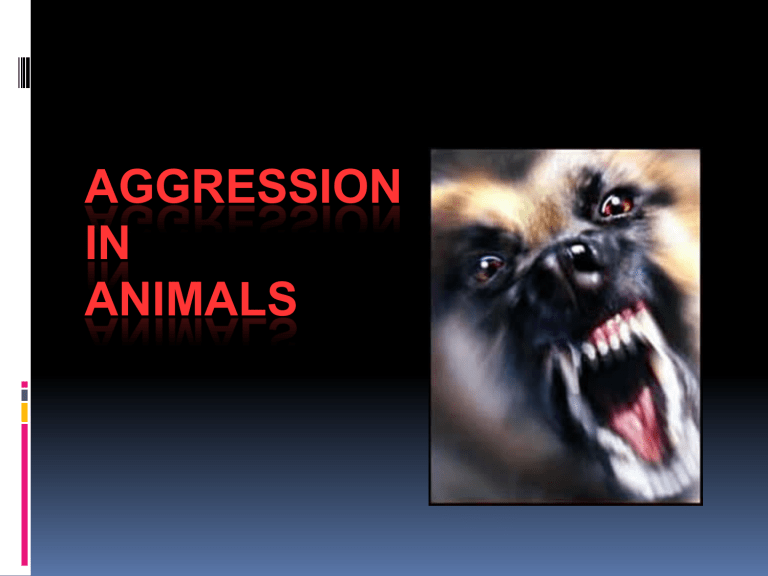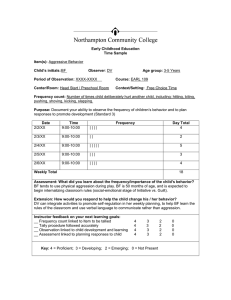
AGGRESSION IN ANIMALS Animals Response to the biotic Environment Responses of animals to other animals can be intraspecific or interspecific They can be further classed as aggressive or co-operative behaviours Aggression Animals often display aggressive acts towards one another. Aggression increases during times of stress. Classification of aggressive behaviours Intra-specific aggression: Intraspecific Aggressive Responses •Agonistic behaviour is aggressive behaviour towards another member of the same species involving threats, submissions, chases and physical combat. Agonistic behaviour is a contest to determine who gains access to a resource. (Does not include predatory aggression for obtaining food) •Conflicts between members of the same species are usually resolved with ritualistic behaviour. This prevents serious injury to the combatants. •Fighting to the death is non-adaptive to most animals. Only occurs when eliminating a stranger from another group. •The more scarce the resource the more intense the fighting. Reasons for Aggressive Behavior • Defense of territory Usually connected with reproduction Sometimes to keep food source • Defense of brood • Repelling competitors for mates (dominance) Features of Aggressive Behaviour •Belligerent behaviour by an animal that threatens to harm or kill another animal with which it is competing. •Combat is more likely to be physical if it is essential to the survival and reproductive success of the competitors. •Natural selection favours a quick end to combat to prevent the winner from becoming too injured, to be able to take advantage of the resources won. •Fighting between males for mates is common. Winner mates with female and passes on genes for successful fighting. Selection may cause males to become larger than females (sexual dimorphism). Types of Aggression Lair or Nest Territory Home range Hierarchical aggression Territories •A territory is an area defended against other members of the same species. •It provides food, water supplies, nesting areas, and refuges from danger. •Ownership of a territory is signalled by vocalisations, scent marking, visual displays. •Boundary marking warns against accidental intrusion by others of its species. •Another animal (rival) is only likely to attempt to dislodge the owner of the territory if it has a chance of being successful. •Territories help to regulate the population to a size that can be supported by the available resources. These New Zealand gannets maintain their individual nesting territories by calling and pecking at each other These New Zealand gannets maintain their individual nesting territories by calling and pecking at each other Dominance -Hierarchies •Many animals that live in social groups have a dominance or social hierarchy •It is established and maintained by agonistic behaviour. •Once established it is maintained by ritualised displays unless a new animal enters the group or a low ranking individual challenges a higher ranking animal. Cuts down competition and tension in the group. •Body postures are common dominance signals Types of Aggression Dominance Hierarchy Dominance aggression Defensive aggression Chickens establish a “peck order” Types of Aggression Abberant Aggression -Cannibalism Tadpoles exhibit cannibalism for avoiding competition for food and space Aggression for mate Rutt in male deers (stags) Resource defense Resource defense Aberrant aggression E.g.: Aggressive Behavior in Fish • Direct charges Often includes biting Ritualistic displays Modified swimming Flaring gill covers Color changes Threatening movements Cannibalism Levels of aggression Predator – Prey •Not truly an aggressive relationship. •Predators can limit a population to a healthy level. •Most predators tend to catch the least well-adapted animal, sick or old. •Keeps the gene pool of the prey strong. •The 2 species are dependent on each others wellbeing. Thank You




